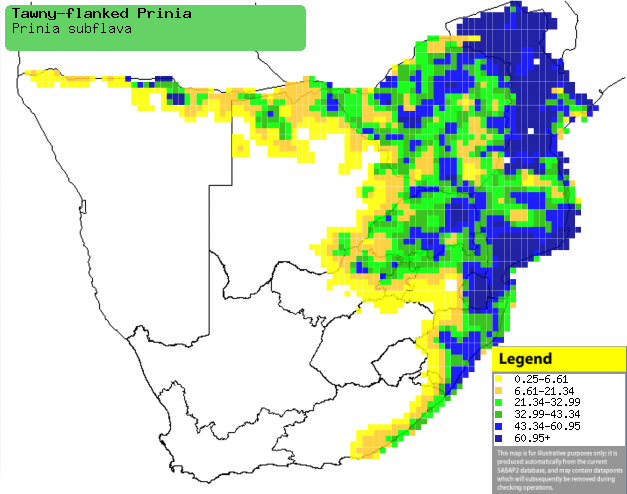|
Prinia subflava (Tawny-flanked
prinia)
Bruinsylangstertjie [Afrikaans]; Ungcuze [Xhosa]; Harudeve
(generic term for cisticola or prinia) [Kwangali]; Timba (generic name for
cisticolas and warblers) [Shona]; Matsinyani [Tsonga]; Roestflankprinia [Dutch];
Prinia modeste [French]; Rahmbrustprinie [German]; Prínia-de-flancos-castanhos
[Portuguese]
Life
> Eukaryotes >
Opisthokonta
> Metazoa (animals) >
Bilateria >
Deuterostomia > Chordata >
Craniata > Vertebrata (vertebrates) > Gnathostomata (jawed
vertebrates) > Teleostomi (teleost fish) > Osteichthyes (bony fish) > Class:
Sarcopterygii (lobe-finned
fish) > Stegocephalia (terrestrial
vertebrates) > Tetrapoda
(four-legged vertebrates) > Reptiliomorpha > Amniota >
Reptilia (reptiles) >
Romeriida > Diapsida > Archosauromorpha > Archosauria >
Dinosauria
(dinosaurs) > Saurischia > Theropoda (bipedal predatory dinosaurs) >
Coelurosauria > Maniraptora > Aves
(birds) >
Order: Passeriformes > Family: Cisticolidae
> Genus: Prinia
Distribution and habitat
Common from southern Asia to much of sub-Saharan Africa,
from Senegal to Ethiopia south to southern Africa. Here it prefers dense grass,
shrubs and bushes along watercourses or in clearings in woodland, edges of old
cultivated farmland and rural villages.
|
 |
|
Distribution of Tawny-flanked prinia in southern
Africa, based on statistical smoothing of the records from first SA Bird
Atlas Project (©
Animal Demography unit, University of
Cape Town; smoothing by Birgit Erni and Francesca Little). Colours range
from dark blue (most common) through to yellow (least common).
See here for the latest distribution
from the SABAP2. |
Brood parasites
It has been recorded as host of the
Brown-backed honeyguide.
Food
It mainly eats invertebrates, foraging on bare ground and
in the undergrowth, sometimes along with other species in a foraging flock. The following food items have been recorded
in its diet:
- Insects
- Nectar
- Aloe greatheadii (Spotted aloe)
- Aloe ferox (Bitter aloe)
Breeding
- The nest (see image below) is built by both sexes, consisting of a pear or
oval-shaped structure with a side entrance, built of woven green grass which
hardens and turns to pale brown as it dries. It is typically attached with
grass to a few upright stems of a sapling, tall shrub, sedge, tall tuft of
grass or bush, often over shallow water or moist ground.
 |
|
|
Tawny-flanked prinia at its nest, Hazyview, South
Africa. [photo Warwick Tarboton ©] |
|
- Egg-laying season is almost year-round, peaking from November-March.
- It lays 2-5 eggs, which are incubated by both sexes for about 13-14
days.
- The chicks are fed by both parents, leaving the nest after about 10-20
days.
Threats
Not threatened.
References
-
Hockey PAR, Dean WRJ and Ryan PG 2005. Roberts
- Birds of southern Africa, VIIth ed. The Trustees of the John Voelcker
Bird Book Fund, Cape Town.
|
